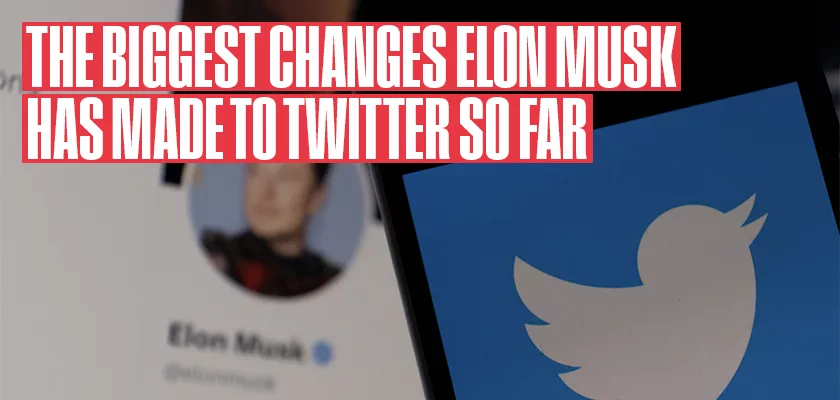
The Biggest Changes Elon Musk Has Made To Twitter So Far
It can be difficult to take a guess at what Elon Musk will do next. Over the past few years, he’s become somewhat of an international man of mystery. No one can ever predict what his next venture will be, or why, for that matter. With an estimated net worth of $192 BILLION, he’s already the founder, CEO and chief engineer of SpaceX, CEO and product architect of Tesla, founder of the Boring Company, owner of X Corp and a lot more (we could go on).
Last year, the billionaire/ the richest man in the world shocked everyone around the world when he announced he would become the owner of the social network Twitter.
After months of back and forths and will he, won’t he, negotiations. He became successful in his triumphs. On the 27th of October, 2023, Elon Musk became the owner of Twitter, paying a staggering $44 billion for the privilege.
Since taking over, there’s been a multitude of changes, with even more on the horizon. We’ve looked into the main changes that have been made since October and the potential rumours of further changes to come!
1. Twitter Blue
You may have heard a whole lot of discourse around Twitter Blue recently, but what actually is it? Since Elon took over the social media company, Twitter Blue was introduced as a new subscription service and a way to create more revenue and monetise the social media platform.
Currently, it costs $8 per month but is still not available on Google Play or Android. In a Tweet from Musk himself, he justified his decision, and Tweeted, “Twitter’s current lords & peasants system for who has or doesn’t have a blue checkmark is bullsh*t. Power to the people! Blue for $8/month.”
The main draw to Twitter Blue is the advantages that come with it. First and foremost, users are paying for the service to have the famous blue tick appear on their profile. The downside, however, is that other Twitter users can see whether verified accounts pay for their tick or not. Before Musk introduced the subscription, an estimated 420,000 users had a tick next to their name. In the beginning days of Twitter Blue, over 140,000 users signed up for the service!
2. Firing Existing Employees
Arguably the most controversial part of Elon Musk’s takeover of Twitter was the way he dealt with the longstanding staff of the social media platform. Boldly declaring that the company was employing too many people, Musk followed out with a mass firing which then subsequently created mass resignations. In just three weeks, the company had gone from around 7500 to just 2700 employees.
The extremity of the mass firing led to multiple strikes by existing Twitter employees over unfair dismissal. And his hard-driving approach to running the company resulted in staff sleeping on the floors of Twitter HQ as a result of gruelling hours and fear of losing their jobs.
3. Advertisements
Brand advertising has been a long-standing entity of Twitter. Pre-Elon, ads on the platform accounted for an average of 90% of Twitter’s overall revenue. So, it’s safe to say that adverts are a fundamental factor in Twitter’s success.
Since Elon has taken over, dozens of Twitter advertisers, including 14 of the top 50, have stopped advertising. Addressing this in a Tweet, Musk voiced his opinion on the matter of advertisements, saying;
Ads are too frequent on Twitter and too big. Taking steps to address both in coming weeks,” adding that there would be a “higher-priced subscription that allows zero ads.
However, according to estimates, top advertisers previously spent $71 million on ads from September to October, and this figure has dropped to $7.6 million (an 89% decline), which suggests the profitability of advertising on Twitter has rapidly decreased since Musk’s involvement with the platform.
4. Letting Publishers Charge For Articles
Another update to Twitter is the rumoured possibility that publishers will charge users to access their content. In a Tweet, Musk said;
Rolling out next month, this platform will allow media publishers to charge users on a per article basis with one click.
This enables users who would not sign up for a monthly subscription to pay a higher per article price for when they want to read an occasional article.…
— Elon Musk (@elonmusk) April 29, 2023
This announcement comes after Musk launched its subscription feature, which allows creators to monetise their content and charge a monthly fee. Twitter is said to take a 10% cut on any content subscription, but only after the first 12 months. The idea behind this is to support content creators but also to seek alternative forms of revenue for Twitter after the loss of advertisers leaving the platform.
5. The Return of Fleets
Back in 2020, Twitter launched their copycat version of Instagram stories called Fleets. Similarly to Instagram stories, Fleets were Tweets that disappeared after 24 hours. However, these didn’t catch on like Instagram stories, which were discontinued in 2021.
In April of this year, Musk confirmed rumours that Fleets might be making a comeback. In a Twitter conversation, a user asked about the potential return of Fleets on the platform, to which Musk replied, “But not in the way it was done last time.”
But not in the way it was done last time
— Elon Musk (@elonmusk) April 26, 2023
6. Timeline Changes
Taking a leaf out of TikTok’s book, Twitter introduced timeline changes so its algorithm has a custom order for recommended Tweets. In January, Musk tweeted, “Next Twitter update will remember whether you were on For You (i.e. recommended), Following or list you made & stop switching you back to recommended tweets.”
7. New ‘Highlight’ Tabs
Finally, another change that has occurred due to Twitter 2.0 is the rumoured introduction of the ‘highlights’ tab. The idea behind it is that it will feature on profiles very much in a similar way to Instagram highlights. Users will be able to add their tweets to a highlight section on their profile to showcase their best Tweets.
The outcome is to win over potential followers and showcase your most-popular Tweets. If this is rolled out across the app, it could be particularly useful for subscription users wanting to increase their revenue.
About Digital Media Team
Digital Media Team are a full-funnel agency, specialising in digital marketing for eCommerce brands.




















